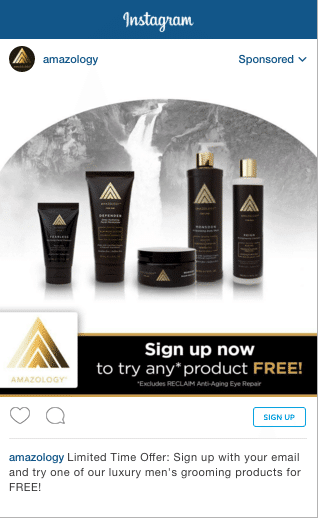Executive Summary:
Amazology came to Today’s Business looking to increase their brand awareness and gain a loyal customer base. To help them achieve their goals, Today’s Business created social media profiles on platforms they weren’t already active on, built website content, and wrote blogs for them. However, this case study will focus on the social media advertisements that Today’s Business utilized to gain traffic to the Amazology website. The statistics below explain how the Instagram Ads resulted in more conversions than the Facebook Ads:
Between March 1st, 2016 and March 22nd, 2016:
- The Instagram Ad resulted in a conversion rate of 40.74%
- The Facebook Ad had only an 0.89% conversion rate
- The amount spent on the Instagram Ad was $161.83
- The amount spent on the Facebook Ad was $639.12
Challenges:
Since Amazology was a new business in the skin-care department, they needed to gain a dedicated following that would help spread the word of their products. This is when the CEO decided it was time to get more involved in social media and look into the advertising opportunities on each platform.
When Amazology came to Today’s Business, they had already created Facebook, Instagram, and Twitter profiles to attract the viral explosion they were hoping to achieve. Unfortunately, they were not gaining the following they wanted with the content they had been posting.
They needed to revamp their content so that it matched the high-end fashion of their brand image. This is where Today’s Business intended to help. Eventually, that same content would be utilized for social media ads to specifically target their audience and result in conversions.
How Product Helped:
Once Today’s Business had created the professional, artistic content that embodied the brand image, they began pushing out specifically targeted website ads on both Facebook and Instagram. These target markets were easy to reach, but the goal was to get conversions through these ads.
Trying to stay within the client’s monthly ad budget, Today’s Business looked to see what the best option would be for both platforms. The estimated CPC for Facebook was $0.74 and Instagram was $2.07. Being that the cost per click (CPC) was much lower for Facebook ads, the results were expected to be better. This was not the case at all.
IG AD
(Product For Free)
Spend: $195.43
Email Sign Ups: 25
Cost Per Acquisition (CPA): $7.81
SEM
(Search Engine Marketing)
Spend: 1,019.17
Email Sign Ups: 5
CPA: $203.83
FB Website AD
(General)
Spend: $639.12
Email Sign Ups: 2
Cost Per Acquisition (CPA): $319.56
After having the ads up for about two weeks, the outcomes showed that Instagram yielded more E-Mail sign ups (conversions) than Facebook. Instagram had the better targeting for these products because the ads were more tailored and only had one call to action, which was to “sign up”. Once users clicked on the offer, they were directed to a landing page that was based off of the Instagram ad. This was once again tailored to that specific type of consumer.

In the end, Today’s Business spent more on circulating the Facebook ad and ended up getting a much lower conversion rate. This may have been due to the targeting options available on the platform. Instagram seems to offer much better targeting options because it is highly based on the interests of the audience, while Facebook’s information on interests may be skewed due to tracking cookies.
Results, Return on Investment, and Future Plans:
These ads were successful for Amazology because they were able to accumulate 75.86% of their e-mail sign ups from the Instagram ad alone. It was also helpful that Amazology recieved e-mail sign ups from the Facebook ad event, even if it was only 6.9% of the total sign ups.
Knowing that Instagram is the better option for conversions is extremely helpful for Amazology and Today’s Business. With this knowledge, Today’s Business can effectively utilize the ad budget to reach the audience that is more likely to get the conversions that the client is looking for.




.svg)